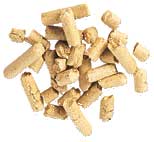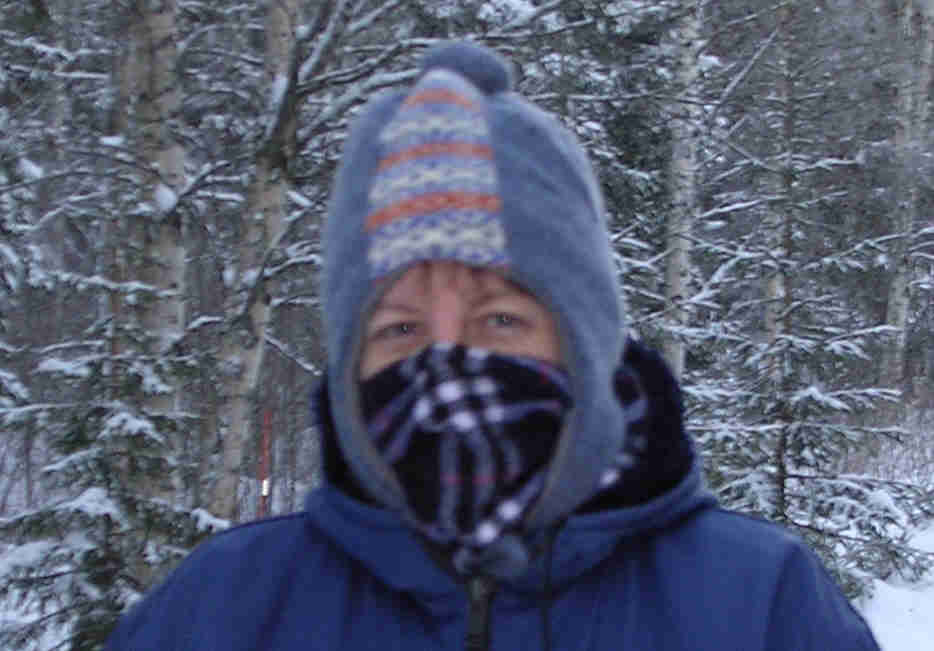February 26, 2006
You Can't Always Get What You Want (Rolling Stones)
The food here is actually better then it is in the states. It is fresher. It doesn’t have all the preservatives that we have in our food. And there aren’t any instant or quick meals like Hamburger Helper. Another thing that is different is the flour. They have several different types of flour here, but nothing close to what we refer to as “All Purpose”. I made a few breads and cakes and they turned out lethal. If I threw them I probably would be serving a life sentence if someone got in the way of one of my projectiles. This happened a couple of times and I became really frustrated. I didn’t know what I was doing wrong. The only thing I noticed was that the flour was heavier. I searched the Internet and found an article comparing flours. I read that all-purpose flour is 1/3 flour and 2/3 chemicals and preservatives. My American-turned- Swedish friend Cheryl said, “You have to make a choice, either pay to have the things you think you can’t live without sent, or just make do with what you have.” I decided instead of sending out begging emails to friends requesting stuff, I would stick with what I had and try to make it work. So instead of using vanilla extract, I am using vanilla sugar. Instead of using shortening, I am using real butter or cooking margarine. But I am not giving up my Fluff, peanut butter and chocolate chips damned it! Consider that a silent request.
February 25, 2006
Break Away (Beach Boys)
There are a lot of activities offered during this week for children/families to participate. For example the museum may have special activities, or a child can learn about different sports such as horseback riding, basketball or floor ball. The swimming hall has special hours to accomodate during sportlov. Some families use this time traditionally to go skiing but some families choose to go to a warmer climate. Ain't Sweden great?
I think it is great having a nationally scheduled week to take off and enjoy a healthy time with your family. What am I doing during spotlov? Well Lars will be away at work which is a bummer but a necessity. I am going to be cooking, killing dust bunnies, having lunch with friends and sleeping in. Doesn’t that sound really sporty?
February 22, 2006
License To Kill (Bob Dylan)
To get a Swedish license you must get permission to get a license (a permit) which you can apply for that over the phone. This is done through Vägverket. They are responsible to licenses and roads. Cost: SEK 275. You have to complete a health form, and you must have a signed certificate from an eye doctor. This information is required as part of the permit process. Then you must take the written test. The cost is SEK 210, but you can pay SEK 800 to cover the written test, the practical test, and the processing fee for your new license. The computer-based test is available in English. THANK GODDESS! There are 70 questions, 65 real questions and 5 "control" questions they check for use on future tests. You have to get 52 right to pass. Then you must do the halkbana. This is a two to three hour course about driving on slippery surfaces. It is not a pass/fail situation, but a completion certification is required. The slippery road certificate needs to be presented when you take the driving test. Then you do the driving test. You are not allowed to schedule this until after you pass your written test, and the waiting can be a few weeks. It is also required that you take the driving test in a car equipped with a passenger set of foot pedals. If you don't have such a car, Vägverket will be happy to rent you one. Cost: SEK 180. The average cost to attempt to get a license is SEK 3700 which is $468!!! GULP! I'm going to need a job just to try and to get a license.
February 14, 2006
Gift Shop (Tragically Hip)
There are many people married in Sweden, however more then half of all children in Sweden today are born outside of marriage. This does not mean that their mothers are single but that many adults choose to cohabit rather than get married. The term in Sweden is “Sambo”, loosely translated, life partner. Some sambo couples get engaged or wear gold bands just like married folks.
The social pressures that exist in the U.S. are nonexistent in Sweden. Parents don't get as upset when their child comes home and tells them they or their girlfriend is pregnant. They don't try to force a marriage simply because there is a child involved. The church doesn't preach about the evils of fornication and having pre-marital sex. Couples have their babies christened in the church and the priests don't have a problem with the marital status of the parents.
If you are married, it is called "Gift". Although it isn't pronounced the same as the english word, I just love this. I think this is such an appropriate word and your spouse should be treated like they are a gift. Of course, being gift or having a sambo doesn't mean relationships are guaranteed to last. People in Sweden divorce, separate and break up. Some people break up with their sambo's and have children with another sambo, just like in America. I don't know what the statistics are, but I don't think they are too different.
Being a person who has been married a couple of times, I have looked at divorce sometimes like it is failure. I envy the family and friends who have been in long term marriages or relationships. My friend Susan, who has been married for over 25 years said the secret to a good marriage is to take one day at a time. I hope someday, many years from now someone asks my gift (because he really is a gift) and I what our secret is.
February 12, 2006
A Warm Place (Nine Inch Nails)

This is a photo of pellets. No, this isn't what we feed hamsters, although it kinda looks like that. This is what we heat our home with. Pellets can replace oil and coal. What are pellets you might ask? Pellets are a refined biofuel, dried and pressed into cylindrical rods of compressed energy. The diameter of each one is between 4 and 12 mm, and the length is between 10 and 30 mm. They are usually manufactured from raw material from Swedish forestry and farming, but bark, paper, grain and hull can also be used. In Sweden alone approx. 800-900,000 tons of pellets are produced annually. Its shape means that it pours easily into silos and feeding systems. Pellets which are stored outside under roofs do not absorb moisture or become frozen. Today the majority of the raw material used to manufacture pellets is sawdust and shavings from sawmills and joinery businesses. Forest growth in Sweden has never been greater than it is now and it exceeds the trees felled by a wide margin. All the oil that is currently imported for heating small houses can be replaced with pellets without this situation changing. One of the greatest threats is climate change caused by increased carbon dioxide emissions. Burning fossil fuels, like oil, coal and natural gas, leads to an increase in the carbon dioxide in the atmosphere. Pellets and wood are biofuels that do not add to the carbon dioxide levels. Combustion in appliances that use pellets takes place via tested process-controlled technology, with optimum efficiency and environmental values below the current limit values. Biofuel from the forests is a sensible choice for the environment and for your finances. It's a renewable energy source and is part of the cycle of nature, which is the basis for an enduring and durable development.
Do you know that this system is also available in the U.S.? Companies like Shell and other oil companies have nationwide distribution.
February 02, 2006
Winter (Tori Amos)

Warning! Graphic Content!
Yesterday at school, a teacher came in to our class to tell us something. She was speaking in Swedish, and from the look on everyones face that could understand her, I knew whatever she was telling them wasn't good. She was telling us about Viral Gastroenteritis. Also known as "Winter Sickness" and "Winter Vomiting Disease". It occurs during winter, comes on suddenly and whoever the unlucky sap is that gets it usually has to sit on the toilet and hold a bucket at the same time for roughly 3 days. Schools, daycare and businesses have closed down due to this seasonal virus.
You should stay away from other people if you do contract it as it is highly contagious. They tell people to wash their hands with hot, soapy water, close the lid of the toilet before they flush, use a bucket instead of the toilet when vomitting, wash any clothing your wore or slept in to kill the germs and pray or learn how to. People who contract it also should drink a lot of something with salt and sugar in it to prevent dehydration and pray.
While Anna-Stina translates this I am getting sick. Mind you it is all in my head. For someone like me who has a comically mild case of OCD, this is trouble. Nervously I look around at my classmates to see if anyone even looks just a little like vomitting. Then I grope around in my bookbag searching for my little bottle of alcohol hand cleaner which I carry with me at all times. I find it to my relief. There is danger everywhere, even in my beautiful Sweden.
http://www.shb.ie/content-1259747958_1.cfm
Indian Reservation (Paul Revere And The Raiders)
Traditionally the Sami are reindeer herders. Families would live in their "Låvvu" (similar to a tepee) during the warm months maintaining their herd of reindeer and travel to another location in the winter. And just like our indians, each Sami "tribe" have their own traditional style of dress (Gåkti) and their own language. The migration paths their herds follow today are the same paths their ancestors took hundreds of years ago. Today the total Sami population is estimated 70,000. While more modern Sami live in cities there is an estimated 10,000 are still involved in reindeer husbandry. Many Sami also make handicrafts which include beautiful sweaters, knives, jewelry, etc. From what I have been told, one of the reasons the Sami people weren't very popular was because of the damage their herds do to the forest and farmlands. However, I am not an authority on this subject. To learn more about the Sami, please copy and paste the links below.
http://www.lysator.liu.se/nordic/scn/faq23.html
http://www.itv.se/boreale/samieng.htm
